2014 Annual Merit Review Awards
Each year, at the Annual Merit Review and Peer Evaluation Meeting, the Hydrogen and Fuel Cells Program presents awards for contributions to the overall efforts of the Program and to recognize achievements in specific areas.
Hydrogen and Fuel Cells Program Awards
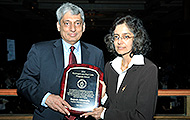
L to R: Rajesh Ahluwahlia, ANL; Sunita Satyapal, Fuel Cell Technologies Office (FCTO).
Rajesh Ahluwalia, Argonne National Laboratory
This award recognizes Dr. Rajesh Ahluwalia of Argonne National Laboratory for his dedication and support of the U.S. Department of Energy's Hydrogen Program. Spanning more than two decades, Rajesh's technical insight and guidance regarding fuel cell, hydrogen storage, and hydrogen production systems analysis has been outstanding. He is the co-developer of GCTool (General Computational Toolkit), a software package that helps design, analyze, and optimize automotive and stationary distributed fuel cell power generation systems, and other power-plant configurations. Rajesh was instrumental in modeling the efficiency and performance of regeneration schemes for spent ammonia borane (AB) while AB was being considered as an on-board source of hydrogen for fuel cell electric vehicles by the Hydrogen Storage Engineering Center of Excellence. More recently he has been modeling balance of plant components and the performance of alternative designs of carbon fiber-wound composite high pressure hydrogen storage tanks. As part of three fuel cell durability projects, he has developed models for Electrochemical Catalyst Stability, Durability, and Performance (eCaSt), which allows prediction of the impact of such properties as catalyst particle size and cell operating conditions on fuel cell stack lifetime. Finally, Rajesh has served as the Operating Agent for the Fuel Cells in Transportation Annex in the IEA Advanced Fuel Cells Implementing Agreement; he coordinates the Annex meetings and tasks (such as preparing a recent report on fuel cell buses authored by the members of the Annex representing Austria, Denmark , Finland, France, Germany, Italy, Korea, Sweden, and the United States).
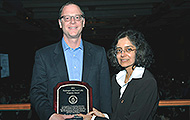
L to R: Brian James, Strategic Analysis, Inc.; Sunita Satyapal, FCTO.
Brian James, Strategic Analysis, Inc.
This award recognizes Brian James of Strategic Analysis, Inc., for outstanding dedication and support of the U.S. Department of Energy's Hydrogen Program. Brian's contributions have included techno-economic analysis of costs and performance of technology pathways, preparation of case studies, and collaboration with national laboratories and industry on analysis tool development. He has been instrumental in the development and publication of numerous, high-impact techno-economic case studies of hydrogen and fuel cell technologies, including studies of photobiological, photoelectrochemical, and PEM electrolysis hydrogen production, onboard hydrogen storage systems, chemical hydrogen storage material regeneration, as well as PEM fuel cell systems for light-duty vehicles and buses; low-temp PEM, high-temp PEM, and SOFC-based stationary power systems; and stationary system installation cost. The broad scope and consistent high quality of his analytical work has been invaluable in the Program's strategic assessment of technologies across its RD&D portfolio.
Hydrogen Production
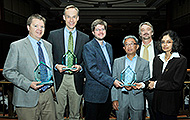
L to R: Todd Deutsch, NREL; Clemens Heske, UNLV; Brandon Wood, LLNL; Tadashi Ogitsu, LLNL; Eric Miller, FCTO; Sunita Satyapal, FCTO.
Todd Deutsch, National Renewable Energy Laboratory; Tadashi Ogitsu, Lawrence Livermore National Laboratory; and Clemens Heske, University of Nevada, Las Vegas
This award recognizes Todd Deutsch of the National Renewable Energy Laboratory, Tadashi Ogitsu of Lawrence Livermore National Laboratory, and Clemens Heske of the University of Nevada, Las Vegas for outstanding dedication and collaboration in photoelectrochemical surface validation. Their ground-breaking work, which integrates state-of-the art tools and methods in materials theory, synthesis, and characterization, has led to the development and validation of novel ab-initio models of photoelectrochemical solar-hydrogen production and corrosion processes. These models have been crucial in the development of corrosion mitigation strategies for high-efficiency photoelectrochemical devices based on III-V semiconductor materials, offering a viable pathway to meet the U.S. Department of Energy's ultimate cost targets in renewable hydrogen production.
Hydrogen Delivery and Safety, Codes and Standards
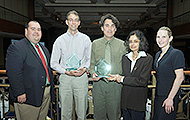
L to R: Will James, FCTO; Brian Somerday, SNL; Chris San Marchi, SNL; Sunita Satyapal, FCTO; Erika Sutherland, FCTO.
Brian Somerday and Chris San Marchi, Sandia National Laboratories
This award recognizes Brian Somerday and Chris San Marchi of Sandia National Laboratories for their outstanding achievements in hydrogen materials compatibility. Brian leads a collaboration of researchers on Hydrogen Compatible Materials within the International Institute for Carbon-Neutral Energy Research (I2CNER) at Kyushu University where he is developing predictive models for hydrogen embrittlement in metals. Brian's ability to build and lead collaborative research has resulted in the development of other research collaborations in the United States, such as his work with Oak Ridge National Laboratory on friction stir welding and with the National Institute of Standards and Technology to align their research efforts related to hydrogen pipelines. Brian has also brought this strength to his new endeavor as Sandia's lead within the newly launched Hydrogen for Infrastructure Research and Station Technology project (H2FIRST). Chris has been an integral part of several code and standard development committees within the International Organization for Standardization (ISO), the American Society of Mechanical Engineering (ASME), and the CSA Group, an internationally-accredited standards development and testing and certification organization. He has also developed several references related to materials compatibility including Sandia's Technical Reference and the White House's Open Energy Information initiative. The latter was the first hydrogen specific reference to be included from the Fuel Cell Technologies Office under President Obama's Open EI Initiative. Chris is also part of international collaboration with National Institute of Advanced Industrial Science and Korea Research Institute of Standards and Science.
Safety, Codes and Standards
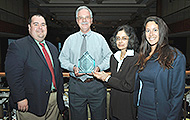
L to R: Will James, FCTO; Steve Weiner, PNNL; Sunita Satyapal, FCTO; Kym Carey, FCTO.
Steve Weiner, Pacific Northwest National Laboratory
This award recognizes Steve Weiner of Pacific Northwest National Laboratory (PNNL) for his achievements and dedication to the Hydrogen Safety Panel. Steve has participated since the initial formation of the Hydrogen Safety Panel in 2003 and served as hydrogen and safety program manager supporting the Hydrogen and Fuel Cells Program from 2006 to 2012. In addition to leading new approaches for hydrogen safety, Steve integrated the work of the Hydrogen Safety Panel, PNNL, other national laboratory staff and organizations, subject matter experts, and a variety of stakeholders to serve the growing interest in hydrogen and fuel cell technologies. Principal work products include the Safety Planning Guidance for Hydrogen and Fuel Cell Projects (2010), the Hydrogen Incident Reporting and Lessons Learned database, the Hydrogen Safety Best Practices database, and first responder classroom and live-fire prop training. Hydrogen Safety Panel meetings led by Steve focused on key safety topics and engaged discussion with all participating stakeholders. Since 2006, he has served as a subtask leader for the International Energy Agency's Hydrogen Implementing Agreement work on hydrogen safety and represents PNNL in the International Association for Hydrogen Safety. Steve and colleagues have published articles in the International Journal of Hydrogen Energy and presented topical papers at the International Conference on Hydrogen Safety, the World Hydrogen Energy Conference, and other technical forums.
Hydrogen Storage
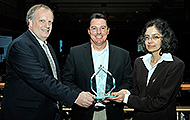
L to R: Ned Stetson, FCTO; Troy Semelsberger, LANL; Sunita Satyapal, FCTO.
Troy Semelsberger, Los Alamos National Laboratory
This award recognizes Troy Semelsberger of Los Alamos National Laboratory (LANL) for his outstanding achievements in analysis and development of chemical hydrogen storage material systems. As the system architect for Chemical Hydrogen Storage Systems within the Hydrogen Storage Engineering Center of Excellence, Troy successfully led a multi-disciplinary team from several institutions that developed system models and component designs and carried out validation testing that demonstrates the potential for chemical hydrogen storage systems. Troy also led the flow-through reactor system development efforts at LANL that successfully demonstrated hydrogen release and clean-up from both ammonia borane and alane slurries. With the results from the experimental and modeling efforts, Troy's team completed the determination of the chemical hydrogen storage materials' properties required to meet the demanding onboard storage performance targets, and presented these results in a webinar hosted by the Office of Energy Efficiency and Renewable Energy's Fuel Cell Technologies Office in June of 2013.
Fuel Cells
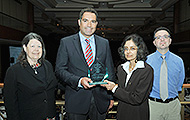
L to R: Nancy Garland, FCTO; Vojislav Stamenkovic, ANL; Sunita Satyapal, FCTO; Dimitrios Papageorgopoulos, FCTO.
Vojislav Stamenkovic, Argonne National Laboratory
This award recognizes Dr. Vojislav Stamenkovic of Argonne National Laboratory for his outstanding achievements in the area of fuel cell catalysts, specifically in reducing the content of platinum group metals in oxygen reduction catalysts. To reduce the cost of fuel cells, the Hydrogen and Fuel Cells Program is pursuing approaches to lower the amount of precious group metals in oxygen reduction catalysts. For several years, Vojislav and his team have employed a materials-by-design approach to design, characterize, understand, synthesize/fabricate, and test advanced nanosegregated multi-metallic nanoparticles and nanostructured thin metal films. They worked to increase the oxygen reduction reaction on multimetallic systems of PtMN-alloys (M=Co, Ni; N=Fe, Mn, Cr, V, Ti, etc.) that will lead to the development of highly efficient and durable real-world nanosegregated Pt-skin catalysts with low Pt content. Recently researchers at the Energy Department's Lawrence Berkeley and Argonne National Laboratories developed a new class of catalysts that could make fuel cells cost-competitive with other technologies. The research team led by Vojislav and Berkeley Lab's Professor Peidong Yang created a nanoframe catalyst that uses ~85 percent less platinum and has more than 30 times the mass activity than conventional catalysts.
Technology Validation
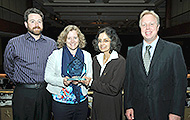
L to R: Jim Alkire, FCTO; Jen Kurtz, NREL; Sunita Satyapal, FCTO; Jason Marcinkoski, FCTO.
Jen Kurtz, National Renewable Energy Laboratory
This award recognizes Jen Kurtz of the National Renewable Energy Laboratory (NREL) for the valuable contributions she has made in support of the Hydrogen Program's technology validation efforts over the last seven years. Jen has developed strong relationships with hydrogen infrastructure providers, automotive OEMs that operate fuel cell electric vehicles, fuel cell companies, and early market technology providers. She brought with her real-world technology experience from her previous role at UTC Power as a Mechanical Integrator. Through her role as the Hydrogen Analysis Group Manager at NREL, she has implemented unique methodologies for the compilation, analysis, and dissemination of data from validation projects, and has provided valuable feedback to both industry partners and to the government on the state-of-the-art of fuel cell electric vehicles, hydrogen infrastructure, and early fuel cell markets. Jen is also recognized for publishing a variety of Composite Data Products that detail the performance characteristics of fuel cell technologies. Through Jen's efforts, the U.S. Department of Energy's Hydrogen and Fuel Cells Program is providing real-world performance data to the R&D community, national and international stakeholders, and the American public.
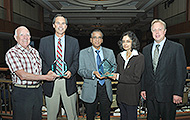
L to R: Sigmund Gronich, retired FCTO; Jack Brouwer, UC Irvine; Pinakin Patel, FuelCell Energy; Sunita Satyapal, FCTO; Jason Marcinkoski, FCTO.
Pinakin Patel, FuelCell Energy; Ed Heydorn, Air Products and Chemicals; and Jack Brouwer, University of California at Irvine
This award recognizes the efforts by several individuals in the development of the world's first tri-generation station—a system that generates heat, hydrogen, and power simultaneously—in Fountain Valley, California. The molten carbonate fuel cell system—developed by FuelCell Energy—runs on biogas generated by the Orange County Sanitation District's wastewater treatment facility. The biogas is cleaned and sent to the fuel cell, which converts the hydrocarbons to a hydrogen rich mixture and produces 250 kW of electricity. A pressure swing adsorber by Air Products further purifies hydrogen, which is sent by pipe to an Air Products fueling dispenser, to enable fueling of 25 to 50 fuel cell electric vehicles. Analyses by the University of California at Irvine of the operation of the system over the past several years have provided key insights. The tri-gen system has generated over 20,000 kilograms of hydrogen; exported close to 3,000 MWh of electricity; and mitigated 21 million SCF of digester gas. The project's funding partners include the U.S. Department of Energy, California Air Resources Board, and the California South Coast Air Quality Management District. Pinakin Patel of FuelCell Energy, Ed Heydorn from Air Products and Chemicals, and Jack Brouwer from the University of California at Irvine are recognized for their outstanding achievements in the successful development and demonstration of tri-generation fuel cell systems.
Market Transformation
Michael Penev, National Renewable Energy Laboratory
This award recognizes Michael Penev of the National Renewable Energy Laboratory for outstanding achievements in early market fuel cell application cost analysis. Mike has been instrumental in leading the development of cost estimates for the Hawaii Hydrogen Initiative (H2I) and the site specific cost analysis for the General Services Administration's (GSA) Fort Armstrong site. One of his key recent contributions has been his analysis and evaluation of the infrastructure development for hydrogen fueling stations in Honolulu for initial infrastructure and full build out stages of development. On the GSA Fort Armstrong site project, Mike led the effort to develop a positive net present value for a first-of-its-kind solar photovoltaic (PV) water electrolysis hydrogen refueling station. Through his creativity and persistence, Mike developed secondary and tertiary revenue streams that resulted in a positive return on investment cash flow scenario by selling PV power to the grid during peak hours and buying off peak grid power for water electrolysis for the hydrogen refueling station.
